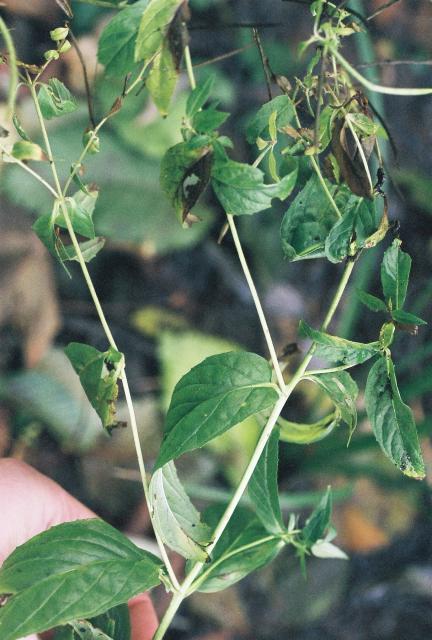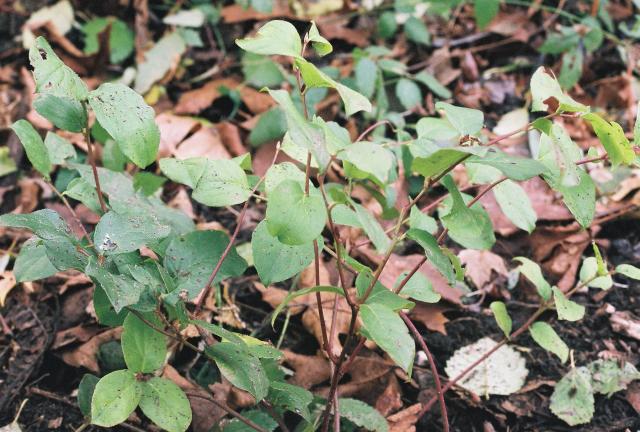User Login |
Plant ListPlants that inhabit the Shady Seasonal Creek
Pacific Willow, Salix lucida spp. lacianra Family: Willow, Salicaceae Description: Slender and tall with waxy, glossy twigs and smooth leaves with soft edges and pointed ends. Has yellow hairy flowers Habitat: River banks, lakeshores, wet meadows Uses: Bark has strong medicinal properties that are similar to aspirin _______________________________________________________________
Touch –me-not, Impatiens noli-tangere, jewelweed Family: Balsam, Balsaminaceae Description: A succulent annual with egg shaped leaves,yellow flowers and small fruits that burst when touched Habitat: Moist forests, streamsides, banks and thickets Uses: Has been used for bee stings, poison ivy rash and insect bites _________________________________________________________________________
Salal, Gaultheria shallon Family: Heather, Ericaceae Description: One of the most common forest understory shrubs. A creeping, usually shorter shrub ( but may vary) with leathery, egg shaped leaves, white flowers and reddish berries Habitat: Coniferous forests, yet found in a number of habitats Uses: Berries have been eaten by a number of indigenous groups, leaves can be chewed as a hunger suppressant and the berries used to sweeten food or made into jam _________________________________________________________________________ Skunk cabbage, Lysichiton americanum, swamp lantern. Family: Arum, Araceae Description: Large leaved perennial with yellow flowers and berry like fruits. Habitat: Swamps, wet forest and wet meadows. Uses: Leaves served as “Indian wax paper” for lining berry baskets and eaten during famine _________________________________________________________________________ Salmonberry, Rubus spectabilis Family: Rose, Rosaceae Description: An erect and golden-brown shrub with prickled branches, darker sharply toothed yellowish leaves and red mushy edible berries Habitat: Found in moist places, especially along stream edges Uses: Berries can be eaten, as well as the sprouts _________________________________________________________________________
Alder, Alnus spp. Family: Birch, Betulaceae Descritpion: A deciduous tree standing up to 32 m tall (the tallest species being Alnus Rubra found in the NW), and has ovate leaves that can be from 7 - 15 cm long with very rigid edges that come to a fine point at the end. The leaves turn very yellow in the fall and the bark is ashey (grey/white) with moss often covering it. Habitat: Native to Western North America and in the NW likes to grow on cool and moist slopes Uses: Leaves and bark are used as an astringent; it is mildly heating and helps to tonify the small intenstine lining to improve food absorption and fat metabolism _________________________________________________________________________
Wild rose, Rosa gymnocarpa, nootkama Family: Rose, Rosaceae Description: A flowering shrub with smallish, sharp thorns, and small ovate leaves with slightly rigid edges. Habitat: Native to the Pacific Northwest. Uses: Rosehips are rich in vit. C and lavinoids. Rose oil in calming and cooling releiving stress. Rose water is an astringent and tightens the skin when applied as a wash. Use the dried flower buds, leaves and hips (after a good frost, says Moore). Infuse buds in water for an eyewash. Leaves are used as an astringent. _________________________________________________________________________ Horsetail, Equisetum arvense Family: Equisetales Uses: The whole herb is used, dried as a diuretic and kidney tonic, to strenghten the mesenchym in kidneys, lungs and liver. The tea is used as a hair rinse as well as a urinary tract cleansure. The roots are palatable (often cooked), young fertile shoots are eaten when peeled and cooked. It also absorbs heavy metals and is high in silica therefore irritating the urinary tract and kidneys if not boiled. Since it is high in calcium and is good for healing bones and connective tissue functions. _________________________________________________________________________
Fireweed, Epilobium angustifolium Family: Willowherb, Onograceae Uses: You can collect the flowers as far down the stem as there are green, unwithered leaves. A tea can be made of the flowers for chronic, pasty, diarrhea. It is used as an anti-inflammatory for the mouth, throat, stomach and intestine. Externally, it cools, soothes and helps bring down swelling. _________________________________________________________________________
Coltsfoot, Petasites Palmatus Family: Aster, Daisy, Compositaceae Uses: Collect the leaves in June-August and the stems (plucked at ground level). Collect the roots in the spring. The tea made of dried herb is used for coughing and intercostal pain. The tincture or root tea lessons stomach cramps, spasms in the gallbladder or the colon. The herb is also smoked for lung irritability (for people who already smoke). the crushed root poltice is used for sprains and contusions by lessening inflammation _________________________________________________________________________ Bracken fern, Pteridium aquilinum Class: Pteridopsida Description: large fronds- usually solitary- triangular blades with a number of leaflet pairs (usually more than ten on each blade)- ranges in between yellow and green Habitat: lakeshores and bogs, dry to wet forests Uses: Native peoples used leaves as liner for pit ovens, rhizomes eaten ( caused constipation) _________________________________________________________________________ Other Various Pictures of Plants on Site Winter Foliage
Growth on a (huckleberry?) plant
Growth on unknown plant
Sword Fern in a bed of alder leaves
Creek
Sources 1. Gunther, Erna. Ethnobotany of Western Washington; the knowledge and use of indigenous plants by native Americans. Seattle: University of Washington Press, 1973. 2. Moore, Michael. Medicinal Plants of the Pacific West. Santa Fe: Red Crane Books, 1993. 3. Pojar, Jim and MacKinnon, Andy. Plants of the Pacific Northwest Coast. Redmond, Wash.; Vancouver:Lone Line Publishing, 1994. 4. Wikipedia: The free encyclopedia. (2006, February 13). FL: Wikipedia Foundation, Inc. Retrieved February 13, 2006, from http://www.wikipedia.org
categories [ Wetland-Shady Seasonal Creek ]
login or register to post comments
|













